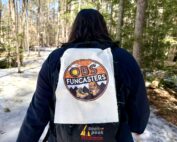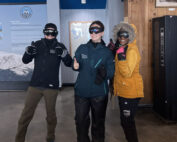Avalanche Safety Class
2013-02-27 17:58:19.000 – Rebecca Scholand, Weather Observer/Education Specialist
NULL
I have now been working on the summit of Mount Washington for three winters and have seen most of what Mount Washington can offer. I have seen wind speeds as high as 140mph, temperatures as low as 35F degrees below zero, and blowing snow so dense, visibility is next to nothing. However, the one thing I have yet to see is an avalanche; and I hope to keep it that way. This past off week I participated in one of the American Institute for Avalanche Research and Education’s (‘AIARE’) Level One class. Through the Eastern Mountain Sports Climbing School, I partook in a three day, 24 hour AIARE class where I learned about safely traveling and assessing avalanche terrain.
In this three day class, I learned more then I ever could have imagined. The knowledge and skills I gained will, without a doubt, be put to use outside the White Mountains, but the knowledge I gained of my own backyard opened my eyes to what Mount Washington can offer outside the realm of weather. One of the most interesting things, for me personally, was learning about wind slabs. As winds race across the summit of Mount Washington and deposit loose snow on the leeward sides of terrain features, top or cross loading can occur. As this snow loads into these areas, a simple human trigger can be all it takes to cause them to avalanche.
If you are considering recreating in the White Mountains of New Hampshire, I encourage you to take advantage of all the resources available to help make safe decisions. Between the Mount Washington Observatory’s Weather Page, the Mount Washington Avalanche Bulletins, or signing up for an AIARE class through Eastern Mountain Sports, you can gain incredible knowledge.
Rebecca Scholand, Weather Observer/Education Specialist
Team Flags Return for Seek the Peak’s 25th Anniversary
Team Flags Return for Seek the Peak's 25th Anniversary By MWOBS Staff Mount Washington Observatory is looking forward to continuing a much-loved tradition for Seek the Peak’s 25th Anniversary: Team flags. In inviting teams
Meet Summer Interns Zakiya, Max and Maddie
Meet Summer Interns Zakiya, Max and Maddie By MWOBS Staff We are excited to welcome six teammates to the summit of Mount Washington this summer! During their internship, these students and graduates will play
Saying Goodbye to the Summit
Saying Goodbye to the Summit By Alexis George After an extraordinary last three years working as a Weather Observer and Meteorologist, I am excited to pursue a different career. As sad I as am




